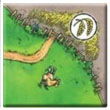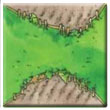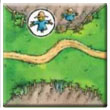Over Hill and Dale Base Game
 |
You are reading the rules for this tile design. |  |
| If your tiles look like this, you have regular Carcassonne tiles. |  |
| If your tiles have a different design, then choose a game from Spin-offs. |  |
Take in the magnificent scenery of this vast countryside by hiking a trail surrounded by fruit trees, wheat fields, and sunflowers! You'll be unable to resist the juicy apples and sweet strawberries you'll find along the way. This rustic new variant of Carcassonne is alive with interesting decisions and intriguing tactics. Gathering a fine harvest, traveling far and wide, and taking care of your animals is reward enough, but it might just win you the game!
General info and comments
Originally released by Hans im Glück in 2015.
A clever tile-laying game for 2 to 5 players, ages 7 and up.
Components and Setup
Welcome to Carcassonne – Over Hill and Dale! These instructions will gently guide you through the rules of the newest variant of the classic Carcassonne. After reading this short rulebook, you will be able to teach it to and play it with your friends. Soon you will be enjoying a refreshing new Carcassonne experience.
First you must set the game up, but that is a simple task. As we guide you through the setup, we will briefly explain the various components.
The 73 Land tiles depict paths and fields, surrounding lush meadows. Animals are also found on many of these tiles.
One of the 73 Land tiles has a blue back. This is the start tile, from which every game begins.
There are 5 tokens each of apples, strawberries, pumpkins, sunflowers, and grain. In addition, there are 8 happy scarecrows.
Place the start tile in the center of the table. Shuffle the remaining tiles facedown. Then split them into several piles and place them around the table, so that each player may reach a pile. Sort the Harvest tokens and place them at the edge of the table.
Then we have the scoreboard, which is also placed at the edge of the table. Next to it, place the 5 50/100 tokens. You will need these later, once you have scored at least 50 points.
There are 25 meeples, 5 each in yellow, red, green, blue, and black. Additionally, in each colour, there are 2 stables. Each player begins with 4 meeples and 2 stables. These form the supply of each player.
Place the 5th meeple of each player colour on the 0 space of the scoreboard. All meeples and stables not used by the players can be returned to the box.
Goal of the Game
Before we begin explaining the rules: what exactly is Carcassonne – Over Hill and Dale all about? What is the goal of the game? Turn by turn, the players place Land tiles. In doing so, they build paths and fields filled with fruits and vegetables.
Your meeples can become wanderers and farmers, and you will build sturdy stables in the meadows. Doing so will score you points both during the game and at the end of it. In the end, whoever has the most points wins!
Let's begin!
Gameplay
Carcassonne – Over Hill and Dale is played in clockwise order. The youngest player begins. As with each player who follows, the active player performs the actions of a turn in the described order. Then it is the turn of the next player in clockwise order, and so on. Let us explore the actions, and the order in which they are performed. We will do so with the tiles depicting paths, fields, and animals. What actions are there?
The Paths
2a. Placing a meeple as a wanderer
Now that you have placed the tile, you may place a meeple as a wanderer on one of its paths. However, you may only do so if there are no wanderers already on the path.
The path is not yet complete, so for the time being, no points are scored (action 3), and play passes to the next player in clockwise order.
The next player draws a Land tile and places it. Your wanderer is already on the path to the left of the junction. Therefore, your opponent may not place his own meeple on that path. Instead, he chooses to place a meeple as a farmer in the field of the tile he just placed.
It is usually good to place a meeple, but never mandatory. You can always choose not to place one.
3. Scoring points
Whenever a path is closed on both ends, it is scored. Paths will end in junctions, fields, or by forming a closed loop. Now we check if anything needs to be scored. Huzzah! We score the road, because both ends of it are closed.
It doesn’t matter who placed the tile, your path is now complete and you score points for it. How many points do you score? Each tile in your completed path scores you 1 point.
This is where the scoreboard comes in. Whenever you score points, you keep track of them by moving your scoring meeple forwards. Continuing our example, we move your scoring meeple 3 spaces forward.
After each scoring, the meeple that was just scored is returned to your supply.
Turn by turn, you will score more and more points. Once you have completed a lap around the scoreboard and crossed the 0 space, take a 50/100 tile and place it in front of you with the 50 side up. If you manage to make it around the scoreboard a second time, flip the tile over to its 100 side.
With the following action, you can score even more points with a path!
3b. Hiking with a wanderer
Under certain conditions, you can now hike with your meeple.
One of your meeples must be on a path. In step 1, you must place a tile to extend this path. Then you may hike this path with your meeple, if and only if you did not place a meeple (or stable) during step 2.
You choose a direction for your wanderer to move, and then have it hike in that direction. You score 1 point for each tile your wanderer moves onto.
In doing so, your meeple may cross other player's meeples. However, your meeple may not stop on a tile where there is another wanderer (i.e., meeple on a path). Mark these points on the scoreboard.
Important rules:
- You may not cross a junction.
- When you place a tile that finishes a path (thereby triggering scoring), you may not move a meeple on that path before scoring occurs. You may only score points for a given path once per turn.
- You may only hike on your own turn. When another player extends your path, you may not choose to hike.
- You may only choose to hike with one wanderer per turn (even when you extend several paths at once).
The Fields
3. Scoring points
Scoring points for a completed field
On your next turn, you draw this tile. Fortunately, it fits your field perfectly. As luck would have it, it even completes the field.
Whenever a field is completely surrounded by meadow and has no holes, it is considered to be complete. Because you have a meeple in this completed field, you now score points for it. Each tile in the completed field scores 2 points.
Harvest tokens on a completed field
Not only do you score points for a completed field, you also gain Harvest tokens. The Harvest tokens are awarded at the same time as points are.
As the owner of the field, you gain 1 corresponding Harvest token for each harvest symbol in the completed field. You keep these collected Harvest tokens facedown in front of you (of course, you may look at your tokens during the game). You will score points for them at the end of the game.
After you have scored your points and collected your Harvest tokens, you return the meeple in the completed field to your supply.
Please see Multiple meeples on the same feature to read how the tokens are awarded when there are multiple farmers in the same completed field.
The Stables
1. Placing a tile
Like always, you draw a tile and place it so that it extends the existing landscape.
2b. Placing a stable
You begin the game with 2 stables in your supply. Stables can only be placed on a meadow depicted on a tile you just placed. If there are several sections of meadow, you may choose which one to place it on. Don't forget: You must decide between placing a meeple, placing a stable, or hiking with a wanderer. You can only perform one of these three actions.
When placing a stable, you must follow one important rule: you may only place a stable on a tile if none of the 8 tiles surrounding it (orthogonally or diagonally) have a stable on them. This rule is only for stables, not for meeples!
Once a stable is placed, it remains there until the end of the game, at which time it may score you points.
It is recommended that you place stables on and bordering tiles with many animals. Each animal is worth 1 point at the end of the game.
3. Scoring points
No points are scored for stables while the game is being played. Stables are only scored at the end of the game (see Game End and Final Scoring). At that time, players will score 1 point for each animal on the tiles surrounding their stable.
Summary
1. Placing a tile
- The Land tile that you draw must be placed so that it extends the existing landscape (i.e., the illustration).
- In some very rare cases, it may be impossible to place a drawn tile. In those cases, simply place the tile in the box and draw a new one.
2. Placing a meeple or a stable
- You may only place a meeple or stable on the tile you just placed.
- You may not place a meeple/stable in a feature already occupied by another meeple/stable.
- You must follow the important stable placement rule: there may not be a stable on any adjacent tile.
3. Scoring points or hiking with a wanderer
- A path is complete when both ends lead to a junction, a field, or form a closed loop. Each tile in a completed path is worth 1 point.
- You may hike when you extend a path, without completing it, occupied by your own meeple. However, you must not have placed a meeple or stable in the same turn. For each tile that the wanderer hikes to, score 1 point.
- A field is complete when it is completely surrounded by meadow and has no holes. Each tile in a completed field is worth 2 points, and each harvest symbol is worth 1 Harvest token.
- Scoring always occurs at the end of a player's turn. All players with meeples in newly completed features have the opportunity to score points.
- After each scoring, return meeples on completed paths/fields to the players' supplies.
- If there are multiple players in a scored feature, the player with the most meeples is awarded the full points, and all other players score nothing. When more than one player has the most meeples in a scored feature, all tied players score full points.
(Note: How can there be more than one meeple in a feature? To find out, read the examples below.)
Multiple meeples on the same feature
Multiple meeples on a path
Multiple meeples in a field

Distribution of Harvest tokens among multiple farmers
As previously explained, you receive 1 Harvest token for each corresponding harvest symbol in a completed field.
If more than one player has the most farmers in a completed field, then the Harvest tokens are distributed as follows:
- First, gather all the Harvest tokens that will be awarded from their respective supplies.
- Then all players tied for most farmers in that field take turns taking Harvest tokens. Start with the player who placed the tile to complete the field, or (if this player is not one of the tied players) the first tied player clockwise.
- This continues until all the awarded Harvest tokens have been taken. It is possible that some players will receive more Harvest tokens than others.
Game End and Final Scoring
Sadly, all good things must come to an end, and the same is true for Carcassonne – Over Hill and Dale. 'Tis a pity, but now we must determine the winner. The game ends after the turn of the player who placed the last tile. Then we proceed to final scoring, after which the winner will be known to all!
Once the game is over, you score points for the following:
Paths
Each incomplete path is worth 1 point per tile, just like during the game.
Fields
Each incomplete field is worth 1 point per tile, which is half the points. Harvest tokens are not awarded during final scoring!
Stables
For each stable, count the animals on the tile the stable occupies and the 8 tiles that surround it. Count every animal (rooster, cow, horse, sheep, and pig) on these 9 tiles. Each animal is worth 1 point. [1]
Harvest Tokens
Each Harvest token is worth 1 point (even the scarecrow). In addition, each set of 5 different fruit tokens (1 each of apple, strawberry, pumpkin, sunflower, and grain) is worth an additional 5 points. Scarecrows may be used as wild tokens, replacing any 1 fruit in a set.
The Winner
Move your scoring meeple forward on the scoreboard to mark the points you are awarded during final scoring.
Whoever has scored the most points is the winner!
If there is a tie for the most points, the players rejoice in a shared victory! Congratulations!
Tile Distribution
Total Regular Tiles: 73
Note: Tiles with multiple versions have various distributions of animals and harvest symbols.
Footnotes
For Icons explanation and licensing please visit Icons page.
- ↑
 You count all the animals on the 9 tiles, even if there are paths or fields separating the animals into different meadows.
You count all the animals on the 9 tiles, even if there are paths or fields separating the animals into different meadows.


































































